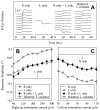Vestibulo-ocular responses evoked via bilateral electrical stimulation of the lateral semicircular canals
- PMID: 18990631
- PMCID: PMC2587291
- DOI: 10.1109/TBME.2008.2001294
Vestibulo-ocular responses evoked via bilateral electrical stimulation of the lateral semicircular canals
Abstract
We investigated the vestibulo-ocular responses (VORs) evoked by bilateral electrical stimulation of the nerves innervating horizontal semicircular canals in squirrel monkeys and compared these responses to those evoked by unilateral stimulation. In response to sinusoidal modulation of the electrical pulse rate, the VOR for bilateral stimulation roughly equals the addition of the responses evoked by unilateral right ear and unilateral left ear stimulation; the VOR time constants were about the same for bilateral and unilateral stimulation and both were much shorter than for normal animals. In response to individual pulse stimulation, the VOR evoked by bilateral stimulation closely matches the point-by-point addition of responses evoked by unilateral right ear and unilateral left ear stimulation. We conclude that, to first order, the VOR responses evoked by bilateral stimulation are the summation of the responses evoked by unilateral stimulation. These findings suggest that--from a physiologic viewpoint--unilateral and bilateral vestibular prostheses are about equally viable. Given these findings, one possible advantage of a bilateral prosthesis is higher gain. However, at least for short-term stimulation such as that studied herein, no inherent advantage in terms of the response time constant ("velocity storage") was found.
Figures








 ), cathodic (▶), and biphasic (▷) pulses. The responses evoked by cathodic and biphasic pulses are indistinguishable, while those evoked by anodic pulses are smaller. (C) Average horizontal eye response to individual pulses applied to the left ear at current levels (from bottom to top) from 40 μA to 110 μA for anodic, cathodic, and biphasic pulses. (D) Peak amplitude of responses evoked by left ear stimulation via anodic (
), cathodic (▶), and biphasic (▷) pulses. The responses evoked by cathodic and biphasic pulses are indistinguishable, while those evoked by anodic pulses are smaller. (C) Average horizontal eye response to individual pulses applied to the left ear at current levels (from bottom to top) from 40 μA to 110 μA for anodic, cathodic, and biphasic pulses. (D) Peak amplitude of responses evoked by left ear stimulation via anodic (
 ), cathodic (◀), and biphasic (◁) pulses. The responses evoked by cathodic and biphasic pulses are indistinguishable, while those evoked by anodic pulses are smaller.
), cathodic (◀), and biphasic (◁) pulses. The responses evoked by cathodic and biphasic pulses are indistinguishable, while those evoked by anodic pulses are smaller.References
-
- Gong W, Merfeld D. A prototype neural semicircular canal prosthesis using patterned electrical stimulation. Ann Biomed Eng. 2000;28:572–581. - PubMed
-
- Gong W, Merfeld D. System design and performance of a unilateral semicircular canal prosthesis. IEEE Trans Biomed Eng. 2002;49:175–181. - PubMed
-
- Merfeld D, Gong W, Morrissey J, Saginaw M, Haburcakova C, Lewis R. Acclimation to chronic constant-rate peripheral stimulation provided by a vestibular prosthesis. IEEE Trans Biomed Eng. 2006;53:2362–2372. - PubMed
-
- Lewis RF, Gong W, Ramsey M, Minor L, Boyle R, Merfeld DM. Vestibular adaptation studied with a prosthetic semicircular canal. J Vestib Res. 2002;12:87–94. - PubMed
-
- Merfeld D, Haburcakova C, Gong W, Lewis R. Chronic Vestibulo-ocular Reflexes Evoked by a Vestibular Prosthesis. IEEE Trans Biomed Eng. 2007;54:1005–1015. - PubMed
Publication types
MeSH terms
Grants and funding
LinkOut - more resources
Full Text Sources
Other Literature Sources

